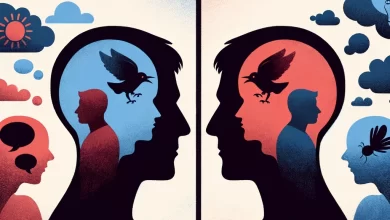Understanding Manic Depressive Disorder FAQs
Do you know what causes extreme mood swings and shifts in energy levels? Have you ever wondered why some individuals experience periods of intense euphoria followed by deep sadness? Let’s delve into the fascinating world of bipolar disorder, also known as manic depressive disorder, and unravel the mysteries surrounding this complex mental health condition.
Bipolar disorder is a mood disorder characterized by alternating periods of manic episodes, where individuals feel extremely energized and euphoric, and depressive episodes, which bring about deep sadness and hopelessness. These mood swings can significantly impact day-to-day tasks and require lifelong treatment.
In this article, we will explore the various types of bipolar disorder, the signs and symptoms to watch out for, how it is diagnosed, the risk factors involved, and the available treatment options. By gaining a deeper understanding of bipolar disorder, we can provide better support and empathy for those living with this mental health condition.
Key Takeaways:
- Bipolar disorder is a mental health disorder characterized by extreme shifts in mood and energy levels.
- It involves manic episodes of high energy and euphoria, as well as depressive episodes of deep sadness and hopelessness.
- There are different types of bipolar disorder, including Bipolar I, Bipolar II, and Cyclothymic disorder.
- Diagnosis involves a combination of physical exams, mental health evaluations, and considering symptoms and family history.
- Treatment includes a combination of medication, such as mood stabilizers, and psychotherapy to manage symptoms and improve quality of life.
What is Bipolar Disorder?
Bipolar disorder, formerly known as manic-depressive illness or manic depression, is a mental illness characterized by significant shifts in mood, energy, activity levels, and concentration. It affects millions of people worldwide, both adults and children. Bipolar disorder involves three main types: Bipolar I, Bipolar II, and Cyclothymic disorder.
Bipolar I is characterized by manic episodes that last at least 7 days and depressive episodes that usually last at least 2 weeks. During manic episodes, individuals experience elevated mood, increased energy levels, racing thoughts, and impulsive behavior. Depressive episodes involve feelings of sadness, hopelessness, and loss of interest in previously enjoyed activities.
Bipolar II includes depressive episodes similar to those in Bipolar I, but with a milder form of mania called hypomanic episodes. Hypomanic episodes are characterized by a heightened mood, increased energy, and increased productivity. Although less severe than full-blown mania, hypomanic episodes can still disrupt daily life.
Cyclothymic disorder refers to recurring periods of hypomanic and depressive symptoms that may not meet the full diagnostic criteria for Bipolar I or Bipolar II. Individuals with cyclothymic disorder experience frequent mood swings, shifting between periods of mild hypomania and mild depression.
It’s worth noting that some individuals may experience symptoms that do not fit neatly into the specific categories of bipolar disorder, which can make diagnosis and treatment more challenging.
What are the Signs and Symptoms of Bipolar Disorder?
People with bipolar disorder may experience distinct signs and symptoms that can significantly impact their daily lives. These symptoms include mood swings, changes in energy levels, behavior, sleep patterns, concentration, and appetite.
Manic Episode
A manic episode is a hallmark symptom of bipolar disorder. During a manic episode, individuals may experience:
- Feelings of extreme euphoria
- High energy levels
- Fast talking
- Racing thoughts
- Decreased need for sleep
Depressive Episode
Depressive episodes are another key aspect of bipolar disorder. During a depressive episode, individuals may experience:
- Feelings of sadness and hopelessness
- Loss of interest in previously enjoyable activities
- Changes in appetite and sleep patterns
- Difficulty concentrating
- Thoughts of death or suicide
These episodes can vary in duration and severity, with some individuals experiencing prolonged periods of mania or depression. The frequency and intensity of mood swings can differ among individuals with bipolar disorder.
It is important to note that everyone’s experience with bipolar disorder can be unique, and not all individuals will have the same signs and symptoms. If you or someone you know is experiencing significant mood changes or other symptoms, it is crucial to seek professional help for accurate diagnosis and appropriate treatment.
| Symptoms | Description |
|---|---|
| Mood swings | Periods of intense emotion, alternating between manic and depressive episodes. |
| Energy levels | Extreme highs and lows in energy, often corresponding to manic and depressive episodes. |
| Behavior | Changes in behavior, such as increased activity levels or impulsivity during manic episodes, and withdrawal or apathy during depressive episodes. |
| Sleep patterns | Disruptions in sleep, with decreased need for sleep during manic episodes and increased need for sleep during depressive episodes. |
| Concentration | Difficulty focusing or concentrating, particularly during depressive episodes. |
| Appetite changes | Fluctuations in appetite and weight, often associated with depressive episodes. |
How is Bipolar Disorder Diagnosed?
Diagnosing bipolar disorder involves a comprehensive evaluation that combines physical exams, medical tests, and mental health assessments. Healthcare providers carefully consider the patient’s symptoms, medical history, personal experiences, and family history to reach an accurate diagnosis. A thorough evaluation is particularly crucial when diagnosing bipolar disorder in youth.
During the physical exam, the healthcare provider may conduct various tests to rule out other medical conditions that may cause similar symptoms. These tests can include blood tests, thyroid function tests, and brain imaging scans to provide a holistic view of the patient’s overall health.
In addition to the physical exam, a mental health evaluation is conducted to assess the individual’s emotional and psychological well-being. This evaluation typically involves a psychiatric assessment, where the healthcare provider will ask detailed questions about the patient’s symptoms, thoughts, feelings, and behaviors. The evaluation may also include screening tools and questionnaires to further assess the presence and severity of bipolar disorder symptoms.
To support the diagnostic process, family history is also taken into account. Bipolar disorder can often run in families, so having a close relative with the condition increases the likelihood of a bipolar disorder diagnosis. Understanding the patient’s family history helps healthcare providers better understand the genetic and hereditary factors involved in the development of the disorder.
It is important to note that bipolar disorder is often associated with other conditions such as anxiety disorders, attention-deficit/hyperactivity disorder (ADHD), substance misuse, and eating disorders. These comorbidities may influence the diagnosis and treatment approach for individuals with bipolar disorder.
Accurate diagnosis is essential for effective treatment and management of bipolar disorder. By combining the physical exam with a mental health evaluation and considering the patient’s symptoms and family history, healthcare providers can ensure a precise diagnosis and develop an appropriate treatment plan.
What are the Risk Factors for Bipolar Disorder?
Risk factors play a significant role in the development of bipolar disorder. By understanding these risk factors, individuals and healthcare professionals can better identify and address the condition. Several key factors contribute to the risk of developing bipolar disorder:
Family History
Having a family history of bipolar disorder is a strong risk factor for developing the condition. Research has shown that individuals with a first-degree relative, such as a parent or sibling, who has bipolar disorder are more likely to develop the condition themselves. Genetic factors play a role in bipolar disorder, but it is important to note that not everyone with a family history will necessarily develop the condition.
Stress
The impact of stress on mental health cannot be understated, and bipolar disorder is no exception. High levels of stress, whether from personal relationships, work, or traumatic events, can trigger the onset of bipolar disorder or exacerbate existing symptoms. Individuals who are prone to stress or have difficulty managing stress may be at a higher risk of developing bipolar disorder.
Substance Abuse
Substance abuse, including alcohol and drug use, is a significant risk factor for bipolar disorder. Drugs and alcohol can disrupt normal brain function and increase the risk of developing bipolar disorder symptoms. Furthermore, individuals with bipolar disorder may turn to substance abuse as a way to self-medicate or cope with their symptoms, creating a harmful cycle.
It is important to note that these risk factors do not guarantee the development of bipolar disorder. Many individuals with no family history or exposure to stress or substance abuse still develop the condition. The interplay between genetic and environmental factors is complex, and ongoing research seeks to further explore the causes and risk factors of bipolar disorder.
How is Bipolar Disorder Treated?
Bipolar disorder is a complex mental health condition that requires lifelong treatment and management. Fortunately, there are various approaches to help individuals with bipolar disorder effectively manage their symptoms and improve their quality of life.
Medication
One common aspect of bipolar disorder treatment is medication. Mood stabilizers, such as lithium and valproate, are frequently prescribed to prevent mood episodes and reduce their severity. These medications help individuals maintain a stable mood and avoid extreme highs (manic episodes) and lows (depressive episodes). In some cases, antipsychotic medications and antidepressants may also be prescribed to address specific symptoms or co-occurring conditions.
Psychotherapy
In addition to medication, psychotherapy plays a vital role in the treatment of bipolar disorder. Psychotherapy provides individuals with a supportive and safe environment to explore their thoughts, emotions, and behaviors related to their condition. It helps them develop effective coping strategies, problem-solving skills, and stress management techniques. Psychotherapy sessions can provide ongoing support, education, and guidance to individuals with bipolar disorder and their families.
Psychoeducation is a key component of psychotherapy for bipolar disorder. It involves educating individuals about their condition, helping them understand the nature of bipolar disorder, and teaching them strategies to manage their symptoms. Psychoeducation equips individuals with the knowledge and skills necessary to identify early warning signs, engage in self-care activities, and make informed decisions regarding their treatment and overall well-being.
Complementary Approaches
Some individuals with bipolar disorder may also benefit from complementary approaches alongside medication and psychotherapy. These may include lifestyle modifications, such as regular exercise, a balanced diet, and adequate sleep hygiene. Additionally, stress reduction techniques, such as mindfulness meditation and relaxation exercises, can help individuals manage stress and promote emotional well-being.
It is important for individuals with bipolar disorder to work closely with their healthcare providers to develop a comprehensive treatment plan that meets their specific needs. Each person’s journey with bipolar disorder is unique, and ongoing evaluation and adjustment of the treatment plan may be necessary to ensure optimal management of the condition.
What is the Difference Between Depression and Bipolar Disorder?
The main difference between depression and bipolar disorder is the presence of manic episodes. While both conditions involve fluctuations in mood, bipolar disorder is characterized by periods of both depression and mania. Depression, on the other hand, is primarily characterized by persistent feelings of sadness, hopelessness, and loss of interest.
In bipolar disorder, individuals experience alternating episodes of depression and mania. During a manic episode, a person may feel extremely elated, euphoric, and have an excess of energy. They may exhibit rapid speech, racing thoughts, and engage in high-risk behavior.
“I felt like I was on top of the world, like I could do anything. My mind was racing, and I had so much energy. I didn’t need much sleep, and I was taking on multiple tasks at once without feeling tired.”
Depression, however, is characterized by persistent feelings of sadness, worthlessness, and a lack of interest or pleasure in activities. Individuals may experience changes in appetite, sleep patterns, and have difficulty concentrating.
When it comes to a diagnosis of bipolar disorder, the presence of at least one manic episode is necessary. A person can have just one manic episode and still be diagnosed with bipolar disorder, as the condition is characterized by recurring episodes of mania and depression.
If you or someone you know is experiencing symptoms of depression or bipolar disorder, seeking a professional diagnosis is crucial in order to access appropriate treatment and support.
Causes and Complications of Bipolar Disorder
Bipolar disorder is a complex mental health condition that is believed to be caused by a combination of genetic factors and biological differences in the brain. While the exact cause is unknown, researchers have found that individuals with bipolar disorder often have family members who have also been diagnosed with the condition, indicating a genetic predisposition. These biological differences in the brain, such as alterations in neurotransmitter levels and brain structure, contribute to the development of bipolar disorder.
Risk factors for bipolar disorder include having a family history of the condition, experiencing high levels of stress, and substance abuse. Individuals with a first-degree relative who has bipolar disorder are more likely to develop the condition themselves. Additionally, stressful life events or traumatic experiences can trigger the onset of bipolar disorder or exacerbate existing symptoms. Substance abuse, particularly drugs that alter mood and energy levels, can also increase the risk of developing bipolar disorder.
Untreated bipolar disorder can lead to various complications, both physical and psychological. Individuals may turn to drugs or alcohol as a way to cope with their symptoms, resulting in substance abuse and addiction. This can further impair their ability to function and maintain healthy relationships. In severe cases, untreated bipolar disorder can also lead to suicide or suicide attempts, requiring prompt intervention and support.
Furthermore, untreated bipolar disorder can have legal and financial consequences, as individuals may engage in impulsive or reckless behaviors during manic episodes. This can result in legal issues or financial difficulties, further exacerbating stress and negatively impacting overall well-being. In addition, bipolar disorder can strain relationships, as the extreme mood swings and behavioral changes can be challenging for loved ones to understand and cope with.
People with bipolar disorder may also have co-occurring conditions, such as anxiety disorders, eating disorders, attention-deficit/hyperactivity disorder (ADHD), or physical health problems. These conditions can complicate the management of bipolar disorder and require additional treatment approaches.
It is essential for individuals with bipolar disorder to seek proper diagnosis and treatment to minimize complications and improve their overall quality of life.
| Complications | Examples |
|---|---|
| Substance abuse | Alcohol addiction |
| Suicide or suicide attempts | Self-harm, suicidal ideation |
| Legal and financial problems | Legal charges, bankruptcy |
| Relationship difficulties | Strained family dynamics |
| Co-occurring conditions | Anxiety disorders, eating disorders |
Conclusion
Bipolar disorder is a complex mental health condition characterized by extreme mood swings. It requires lifelong treatment and management for individuals to effectively manage their symptoms and improve their overall quality of life. Early diagnosis and prompt treatment are crucial in successfully managing the condition.
With a combination of medication and psychotherapy, individuals with bipolar disorder can find relief from their symptoms. Medications such as mood stabilizers, antipsychotics, and antidepressants help to stabilize mood and prevent episodes. Psychotherapy provides support, education, and guidance, helping individuals understand their condition and develop coping strategies.
Managing bipolar disorder is an ongoing process that requires commitment and dedication. By working closely with healthcare professionals, individuals with bipolar disorder can lead healthy and active lives. Regular monitoring and adjustments to treatment plans ensure that symptoms are effectively managed. Mental health plays a significant role in overall well-being, and with proper care, individuals with bipolar disorder can thrive and achieve their goals.






